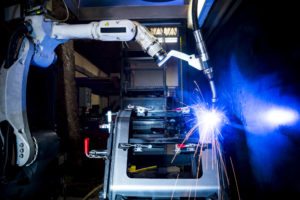Robotic Welding: How Manufacturers Realize ROI, Part 1
 Series Introduction
Series Introduction
Return on investment (ROI) is a key consideration for determining whether automation is right for your company. Due to inherent safety and efficiency challenges of manual processes, robotic welding is one of the most common types of robotic automation. Robotic welding cells have seen years of innovation and advances born from high demand, and small and large manufacturers alike are discovering how effective they are.
The Robotic Welding Series takes a deep dive into the functional benefits of robotic welding processes, demonstrating how this translates into ROI for manufacturers across industries. The series aims to provide you with a clear understanding of how robotic welding cells can fit into your manufacturing processes to enhance productivity and efficiencies.
Part 1: Avoiding Rework and Excessive Material Consumption
One of the main ways that robotic welding cells enhance productivity and efficiency, and ultimately ROI, is repeatability. When welding processes are repeatable to a high degree of accuracy, the need for rework is reduced or eliminated, resulting in lower consumption of product and welding material.
Eliminating the Challenge of Manual Over-Welding
A common challenge among manual processes is over-welding. For example, a weld bead just 1/8-inch larger than it’s supposed to be can double filler metal costs. This may be a small amount at first, but certainly adds up over time.
Over-welding can also create distortion on a part, especially in larger parts. Distortion will often lead to rework, which is a major waste of resources. Any time spent re-welding a part instead of welding a new part is an unproductive use of labor and materials. Sometimes, distortion can be too bad to fix and the material is unusable, further wasting valuable resources.
Accurate Repeatability Reduces Waste
Welding robots are accurate within 5-thousandths of an inch. This accuracy is repeatable almost indefinitely, as long as proper maintenance and upkeep procedures are followed. Robotic welding cells use only the resources necessary to weld a part, and due to its consistency, there are no wasted part materials.
The repeatability of robotic welding also results in consistently high-quality parts coming off your production lines. This is a key consideration when evaluating manual processes versus robotic processes.
Robotic welding delivers measurable ROI for time-consuming manual processes that can result in over-welding, part distortion, material waste, and the need for reworking. As long as the robot is correctly programmed, part distortion is virtually eliminated, along with wasted time, labor and welding consumables.
To learn more about robotic welding ROI, read Part 2 of the series next Tuesday: Increased Uptime and 85% Efficiency.
Posted in Robotic Welding